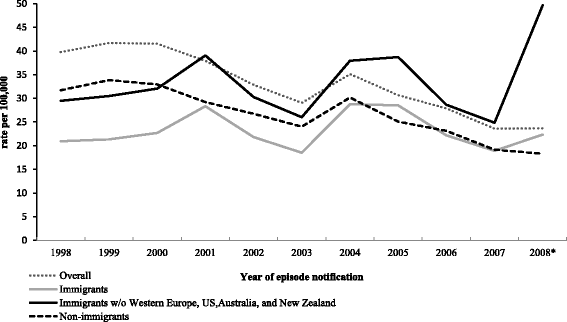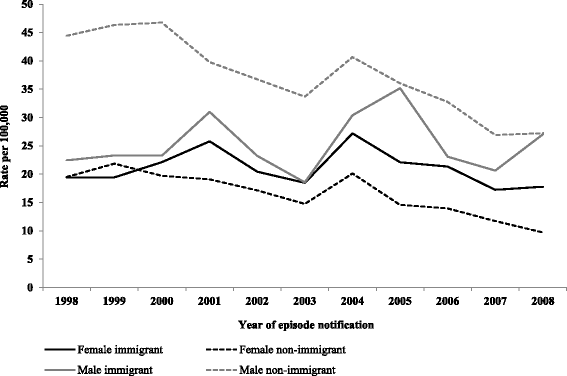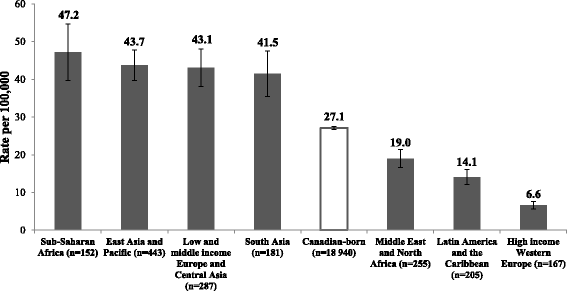A population-based study of chronic hepatitis C in immigrants and non-immigrants in Quebec, Canada
- PMID: 28193199
- PMCID: PMC5307836
- DOI: 10.1186/s12879-017-2242-y
A population-based study of chronic hepatitis C in immigrants and non-immigrants in Quebec, Canada
Abstract
Background: Immigrants originating from intermediate and high HCV prevalence countries may be at increased risk of exposure to hepatitis C infection (HCV) in their countries of origin, however they are not routinely screened after arrival in most low HCV prevalence host countries. We aimed to describe the epidemiology of HCV in immigrants compared to the Canadian born population.
Methods: Using the reportable infectious disease database linked to the landed immigration database and several provincial administrative databases, we assembled a cohort of all reported cases of HCV in Quebec, Canada (1998-2008). Underlying co-morbidities were identified in the health services databases. Stratum specific rates of reported cases/100,000, rate ratios (RRs) and trends over the study period were estimated.
Results: A total of 20,862 patients with HCV were identified, among whom 1922 (9.2%) were immigrants. Immigrants were older and diagnosed a mean of 9.8 ± 7 years after arrival. The Canadian born population was more likely to have behavior co-morbidities (problematic alcohol or drug use) and HIV co-infection. Immigrants from Sub-Saharan Africa, Asia and Eastern Europe had the highest HCV reported rates with RRs compared to non-immigrants ranging from 1.5 to 1.7. The age and sex adjusted rates decreased by 4.9% per year in non-immigrants but remained unchanged in immigrants. The proportion of HCV occurring in immigrants doubled over the study period from 5 to 11%.
Conclusions: Immigrants from intermediate and high HCV prevalence countries are at increased risk for HCV and had a mean delay in diagnosis of almost 10 years after arrival suggesting that they may benefit from targeted HCV screening and earlier linkage to care.
Keywords: Hepatitis C; Immigrant; Incidence; Rates; Viral hepatitis.
Figures




Similar articles
-
Addressing hepatitis C in the foreign-born population: A key to hepatitis C virus elimination in Canada.Can Liver J. 2018 Jul 17;1(2):34-50. doi: 10.3138/canlivj.1.2.004. eCollection 2018 Spring. Can Liver J. 2018. PMID: 35990716 Free PMC article. Review.
-
Hospitalizations in Immigrants and Nonimmigrants Diagnosed With Chronic Hepatitis C Infection in Québec.Clin Infect Dis. 2016 Dec 1;63(11):1439-1448. doi: 10.1093/cid/ciw540. Epub 2016 Aug 7. Clin Infect Dis. 2016. PMID: 27501843
-
A population-based study of reported hepatitis C diagnoses from 1998 to 2018 in immigrants and nonimmigrants in Quebec, Canada.J Viral Hepat. 2023 Aug;30(8):656-666. doi: 10.1111/jvh.13837. Epub 2023 Apr 18. J Viral Hepat. 2023. PMID: 37070269
-
Epidemiology of varicella among immigrants and non-immigrants in Quebec, Canada, before and after the introduction of childhood varicella vaccination: a retrospective cohort study.Lancet Infect Dis. 2021 Jan;21(1):116-126. doi: 10.1016/S1473-3099(20)30277-2. Epub 2020 Jul 23. Lancet Infect Dis. 2021. PMID: 32711690
-
Epidemiology and management of hepatitis C virus infections in immigrant populations.Infect Dis Poverty. 2019 Mar 15;8(1):17. doi: 10.1186/s40249-019-0528-6. Infect Dis Poverty. 2019. PMID: 30871599 Free PMC article. Review.
Cited by
-
Epidemiology of Hepatitis C over 28 years of monitoring Canadian blood donors: Insight into a low-risk undiagnosed population.BMC Public Health. 2024 Aug 27;24(1):2319. doi: 10.1186/s12889-024-19790-2. BMC Public Health. 2024. PMID: 39192303 Free PMC article.
-
Prescribing trends in direct-acting antivirals for the treatment of hepatitis C in Ontario, Canada.Can Liver J. 2021 Feb 24;4(1):51-58. doi: 10.3138/canlivj-2020-0025. eCollection 2021 Winter. Can Liver J. 2021. PMID: 35991476 Free PMC article.
-
Migration Health: Highlights from Inaugural International Society of Travel Medicine (ISTM) Conference on Migration Health.Curr Infect Dis Rep. 2019 Nov 16;21(12):48. doi: 10.1007/s11908-019-0705-6. Curr Infect Dis Rep. 2019. PMID: 31734735 Review.
-
Addressing hepatitis C in the foreign-born population: A key to hepatitis C virus elimination in Canada.Can Liver J. 2018 Jul 17;1(2):34-50. doi: 10.3138/canlivj.1.2.004. eCollection 2018 Spring. Can Liver J. 2018. PMID: 35990716 Free PMC article. Review.
-
Prevalence of Hepatitis C Among Migrants: A Systematic Review and Meta-Analysis.J Viral Hepat. 2025 Apr;32(4):e70025. doi: 10.1111/jvh.70025. J Viral Hepat. 2025. PMID: 40116740 Free PMC article.
References
MeSH terms
LinkOut - more resources
Full Text Sources
Other Literature Sources

